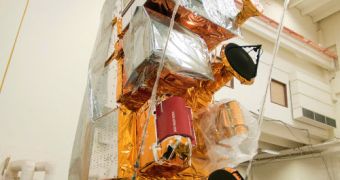Officials with the Ball Aerospace & Technologies Corp. announce the successful completion of thermal vacuum testing for the NPOESS Preparatory Project (NPP) satellite. The spacecraft is now brought even closer to completion, and remains on track for an October 25 launch date.
According to experts at the company, the new tests lasted for no less than two months, during which time both the satellite and its instruments had their performances monitored closely. The goal of the assessments was to determine whether they work well together.
Another was to see if this can happen in the harsh conditions the spacecraft will be subjected to once it launches into space. The investigation concluded on April 27, Ball Corp. representatives announce.
At this point, the NPP vehicle is subjected to post-environmental performance testing, and this assessment stage will shortly be followed by a pre-shipping review. The vehicle will be shipped out this August, as the company finishes conducting all tests.
The satellite will be sent to the Lompoc, California-based Vandenberg Air Force Base (VAFB), which has the capabilities necessary to launch such large satellites into space. Once launched, the NPP will be put on a polar orbit, which is commonly used by weather and spy satellites.
“Given the fact that the US has more severe weather than any other country, it’s crucial that decision makers have seamless data from the nation’s next weather satellite to protect the country’s economic stability,” explains Ball Corp. official Cary Ludtke.
“This major milestone puts NPP a step closer to providing those continued observations,” adds the representative, who is the vice president and general manager of the corporation's Civil and Operational Space Business Unit.
The five instruments on NPP are the Visible/Infrared Imager Radiometer Suite (VIIRS), the Cross-track Infrared Sounder (CrIS), the Advanced Technology Microwave Sounder (ATMS), the Ozone Mapping and Profiler Suite (OMPS) and the Clouds and the Earth Radiant Energy System (CERES).
This satellite is based on Ball Corp.'s BCP 2000 spacecraft bus. The vehicle is being constructed under a contract the company signed with the NASA Goddard Space Flight Center (GSFC), in Greenbelt, Maryland.
NPOESS stands for the National Polar-orbiting Operational Environmental Satellite System, which was to be the United States' next-generation weather satellite system.

 14 DAY TRIAL //
14 DAY TRIAL //